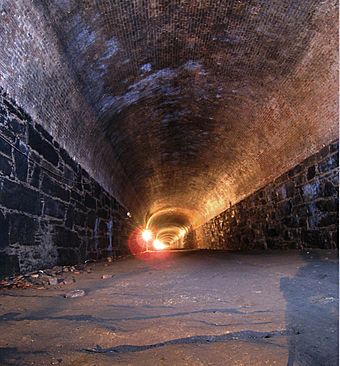Cobble Hill Tunnel facts for kids
Quick facts for kids |
|
|
Cobble Hill Historic District
|
|

The tunnel in 2009
|
|
| Lua error in Module:Location_map at line 420: attempt to index field 'wikibase' (a nil value). | |
| Location | Brooklyn, New York City |
|---|---|
| Built | 1844 |
| Architect | Asa Stebbins |
| Architectural style | Roman, Italianate, Queen Anne |
| NRHP reference No. | 89001388 |
| Added to NRHP | September 7, 1989 |
The Cobble Hill Tunnel (also known as the Atlantic Avenue Tunnel) is a very old, abandoned railway tunnel in Brooklyn, New York City. It runs beneath Atlantic Avenue through the neighborhoods of Downtown Brooklyn and Cobble Hill. When it was open, it stretched for about 767 meters (2,517 feet). This tunnel is special because it's the oldest railway tunnel under a city street in North America. It was built just for trains!
Contents
Building the Tunnel
Construction on the tunnel started in May 1844. It first opened for use on December 3, 1844. The tunnel was fully finished by mid-1845. It was originally built as an "open cut," which means it was like a big ditch.
Why Was It Built?
The main reason for building the tunnel was to make a safer path for the Long Island Rail Road (LIRR). People wanted the trains to have their own special route. This route would lead to the South Ferry in Brooklyn. From there, passengers could catch ferries to Manhattan. Building the cut also made the LIRR's path lower through Cobble Hill.
From Cut to Tunnel
The cut was about 6.4 meters (21 feet) wide and 767 meters (2,517 feet) long. About five years after it opened, a roof was built over the open cut. This turned it into the tunnel we know today. Once roofed, the tunnel was about 5.2 meters (17 feet) high inside.
Early Train Travel
Because the tunnel was built, the City of Brooklyn allowed the LIRR to use its steam trains on Atlantic Street. This was a big deal! Before the tunnel, horses pulled the train cars for part of the journey. The Cobble Hill Tunnel was part of the first train route between New York City and Boston, Massachusetts. This route helped people travel faster between these big cities.
When Did It Close?
The ends of the tunnel were sealed up in the fall of 1861. This meant trains could no longer use it.
The Tunnel's Long Sleep
After it closed, the tunnel was mostly forgotten by the public. But it became a place of local stories and legends.
Rumors and Searches
In March 1916, some people thought secret agents might be using the tunnel. They broke through the roof to check, but found nothing. They put in a light and sealed it up again. In the 1920s, there were rumors that the tunnel was used for growing mushrooms or even for making illegal drinks. In 1936, the New York City Police Department tried to get into the tunnel. They were looking for someone who was rumored to be buried there, but they couldn't get in. Later, in the 1950s, two train historians tried to find the tunnel, but they couldn't get inside either.
Rediscovering the Tunnel
The tunnel stayed hidden for a long time. Then, in 1980, a 20-year-old named Robert Diamond found it! He got in through a manhole at Atlantic Avenue and Court Street. He had to crawl through a very small, filled-in part of the tunnel. It was less than 0.6 meters (two feet) high!
Breaking Through
Robert Diamond found a huge concrete wall that sealed off the main part of the tunnel. With help from a gas company crew, he broke through this thick wall. This opened up the main part of the tunnel again.
Sharing the Discovery
After his discovery, Robert Diamond started telling everyone about the tunnel. He even led tours inside it from 1982 until 2010. The tunnel is now listed on the National Register of Historic Places. This means it's an important historical site.
The History Channel even featured the tunnel on its show Cities of the Underworld in 2008.

